Motorcycle leather suit vs textile suit. Which is best?
Published on: 12 January 2022
Some time ago we launched a new service called ‘Ask the Chap’, where we invite people to ask questions about motorcycle gear. One of the questions that has come up a lot is: what’s best, leather gear or textile gear? And so today I am going to try and provide an answer on that hotly debated topic.
And it is hotly debated. Those who have always worn leathers, and who perhaps came up through sportsbikes are often of a mindset that won’t consider anything but leather; deeming it to be the only thing you can wear to stay safe on the bike.
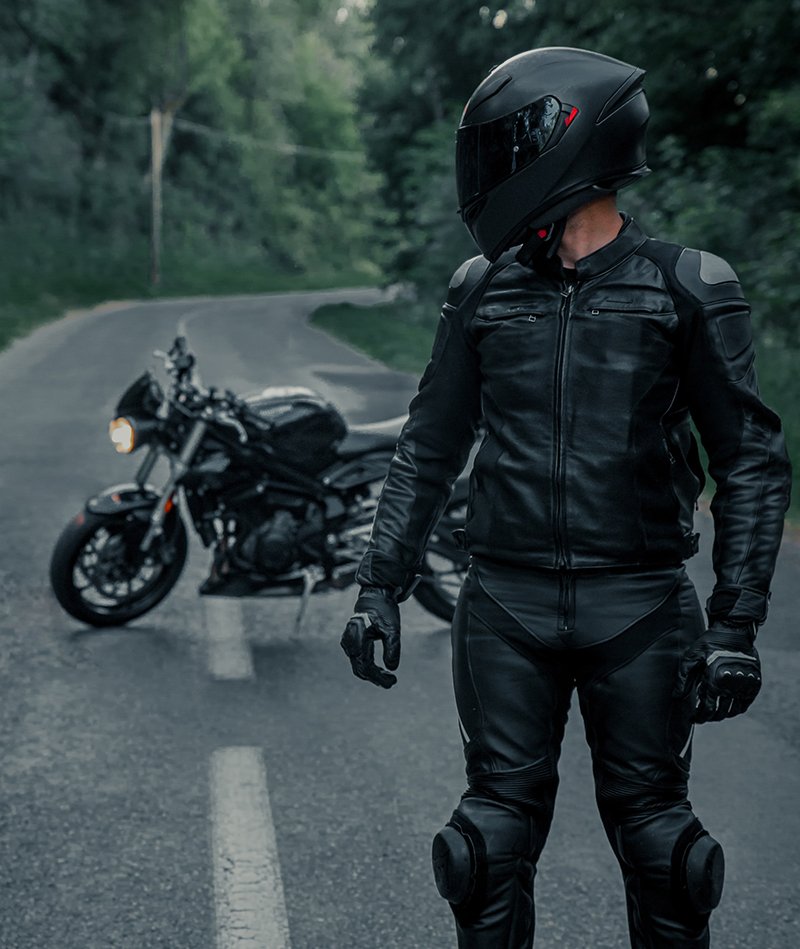
We often see these people in the shop; and whatever case you put to them about some of the benefits of textile garments is greeted with scorn. And these guys will say anything they feel they need to, in order to justify their chosen form of dress.
In truth, this defence mechanism isn’t that unusual. It’s all about avoiding what psychologists call ‘cognitive dissonance’. And this entails telling ourselves and others little stories to justify our actions, even if these little tales don’t hold water.

Let me give you an example. Say I decide that I want to buy myself a classic MV Agusta. (Actually this bit really is true). It’s not going to be cheap. (Actually, this bit is true too). So I would have to try and justify it; not only to myself, but also to Sara. The truth is that I have simply lusted after one since I was a teenager. But I will tell Sara that I see this bike as an investment. I will point out that we will never lose money on it, that classic insurance is cheap and that bikes of this era are relatively easy and inexpensive to maintain. I might tell her how much safer I will be on one of these than I would be on a sportsbike. I will say anything I need to, both to Sara and myself, in order to avoid a paralysing emotional conflict that might see me stepping back from doing what I clearly want to do.
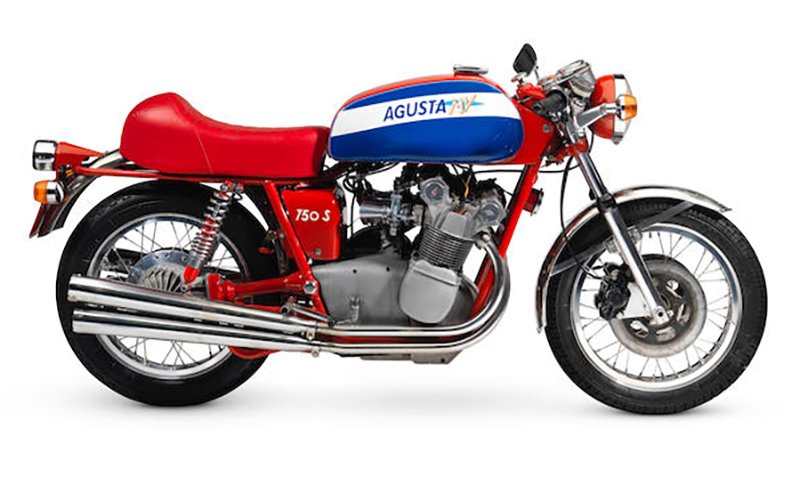
Well, that’s what a lot of people who will only wear leather have done over a number of years, to shield themselves from having to consider textile garments. And this is why this is such an emotionally fraught topic. I have written about this before, and I know that the leather boys can get very agitated!
As a seller of motorcycle clothing, we do not stock or sell any one-piece leather suits. And this might lead some people to question whether we have some kind of bias or agenda. My view is that we don’t.
I have a one-piece leather suit, as does Sara. Hers is more colourful than mine. One feels very secure and protected in a leather suit, but we would only ever wear them at a circuit. The one-piece is really meant for the track. And if you have an accident on track, as I have had on numerous occasions, a one-piece is what you want to be wearing. Leather is naturally abrasion resistant, which is important if you come off at a hundred miles an hour. Leather slides really well and smoothly in a way that textile garments don’t. We’ve all watched racers slide for tens of metres on the track. Going down the track in a textile suit, the chances are that you’d roll and tumble far more.
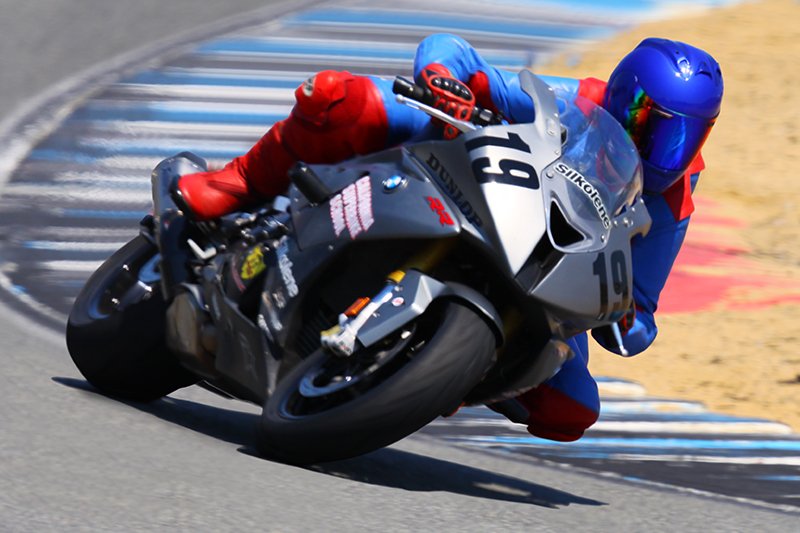
I also have a two-piece leather touring suit; and for some rides in some conditions this is still my favoured form of attire. And so personally I don’t think we have an agenda. Yet I cannot deny that I am not a fan of the one-piece leather suit for road riding.
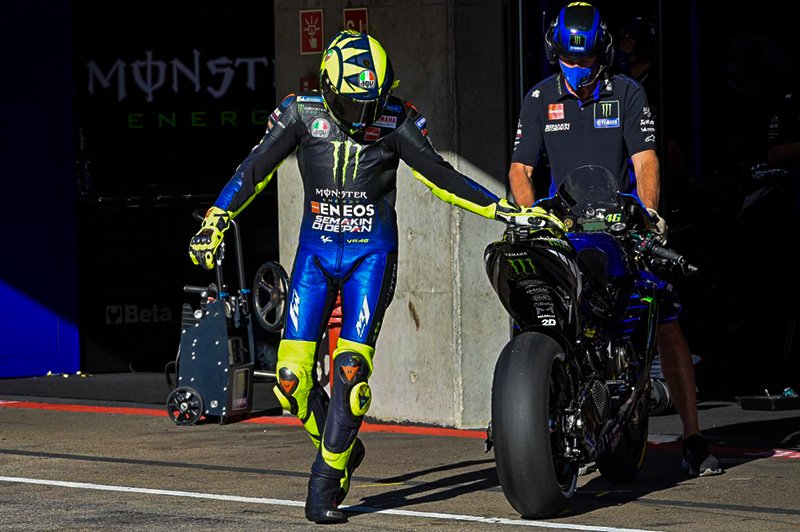
I think it is totally impractical. In a one-piece suit it is difficult to walk around and not look like the hunchback of Notre Dame. This is fine when all you’ve got to do is get from the pit-lane garage to the bike, but it looks and feels less appropriate when you want to walk around a village, go into a restaurant, or spend the day at a show or a race meeting of some kind. A one-piece is also a major pain if you need to have a Number 2!
But I am not a fan of one-piece leathers on the road for another reason. And that’s what I am going to talk about next!
There is an extent to which wearing a one-piece leather suit on the road is somewhat of an affectation. But there’s nothing wrong with this. Many bikers, some knowingly, some less knowingly, end up wearing outfits that are in keeping with their bikes. Commuters and professional riders aside, motorcycles these days often represent a lifestyle choice.
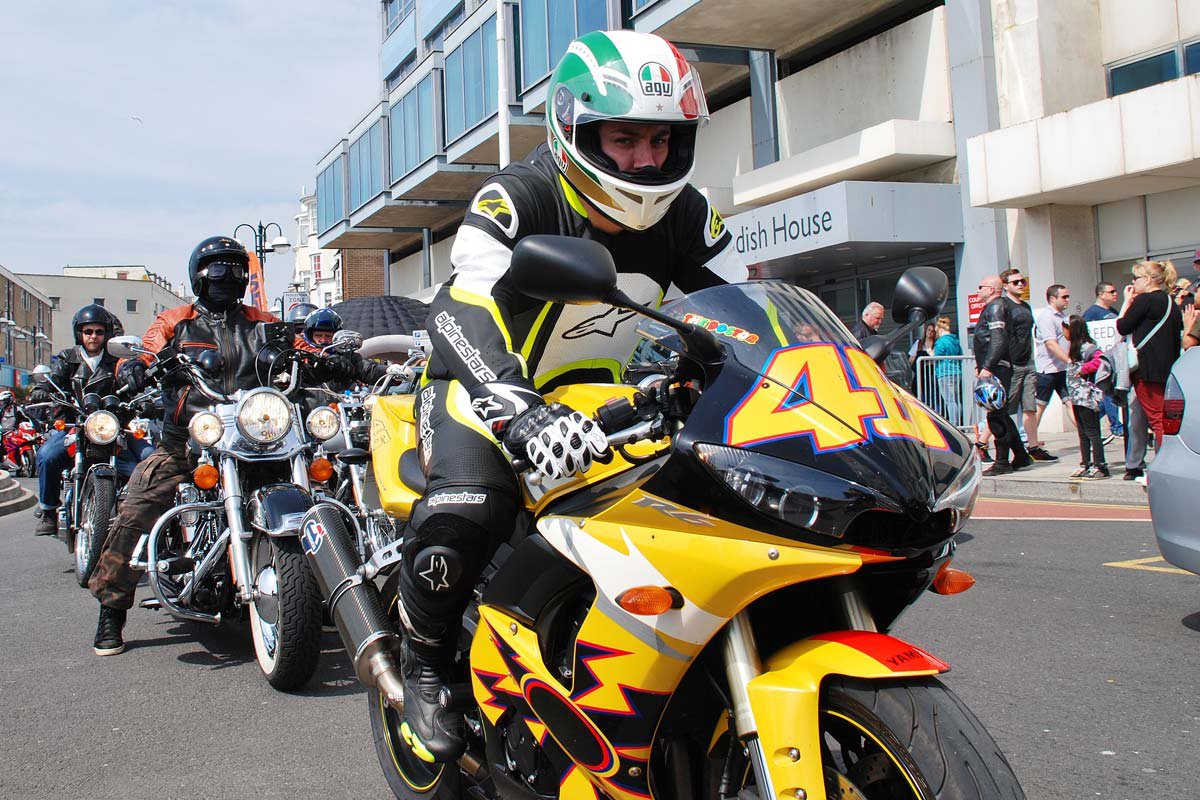
When you buy a GS from your local BMW dealer, the sales guy will often tempt you to buy one of those suits that make you look like you’re ready for the Paris-Dakar. You may well walk out with a pair of boots with buckles up the calves and a helmet with a peak; essential for negotiating the setting sun as you stop at Waitrose to pick up dinner. Buy a Bonneville or Z900 RS, and you’ll want a seventies’ style leather jacket, some cool motorcycle jeans and short biker boots. You’ll also need an appropriate, retro-looking helmet. Get your yourself something bikeshedy, you’ll want to go full-on hipster. A pair of Redwing boots. Jeans that end halfway up your calves. A helmet that looks like something Chuck Jaeger might have worn. And probably some tattoos and tidily-groomed facial hair.
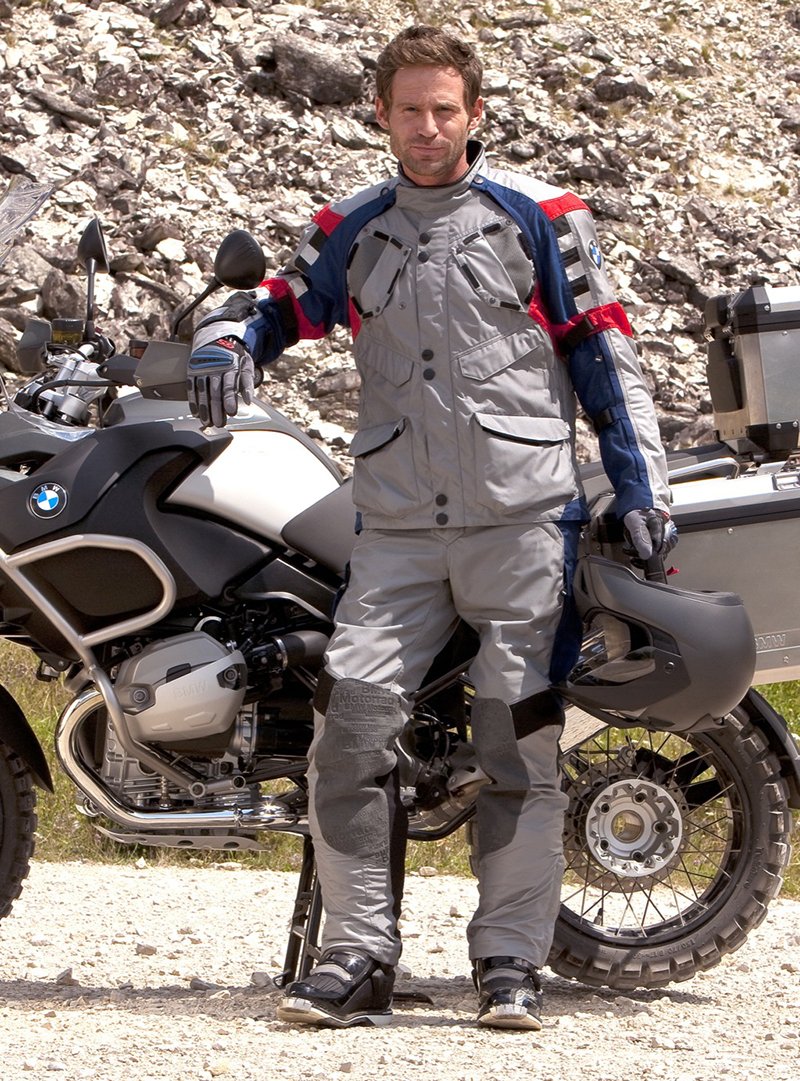
All this is pretty normal. Nobody likes to admit they are influenced to dress in accordance with the style of the bike, but here in the shop we see evidence of this every single day. And so, when you have a sportsbike, the look is truly only completed with a one-piece race suit.
But the truth is that it is quite difficult to ride any high-performance sportsbike in what one might term a restrained manner. We are often talking about bikes that can reach the national speed limit in first gear. A sportsbike encourages the rider to ride in a spirited manner. Of course, the throttle goes both ways, but you’re leant over the tank like a racer, and all it takes is a gentle twist of the grip and you’re doing three-figure speeds. No issue with this. Ferraris are pretty fast too!

The problem is that when you combine a sportsbike with a one-piece leather suit, you put yourself in full ‘racer’ mode. A leather suit is a very reassuring garment to wear. You don’t quite feel invincible, but you do feel very secure and protected. It is difficult to put a leather suit on and not feel a little like a super-hero. That’s sometimes helpful on the track, but a little more concerning on the road, for it can encourage the rider to put on just a little more gas.
There’s lots of evidence to back this up. And one sees it on the road all the time; particularly on a Sunday morning. The rider on a sports-tourer may be happy negotiating a roundabout at thirty, but the one-piece clad, sportsbike rider will want to show that he can tackle it at fifty, probably attempting to get his knee down in the process.
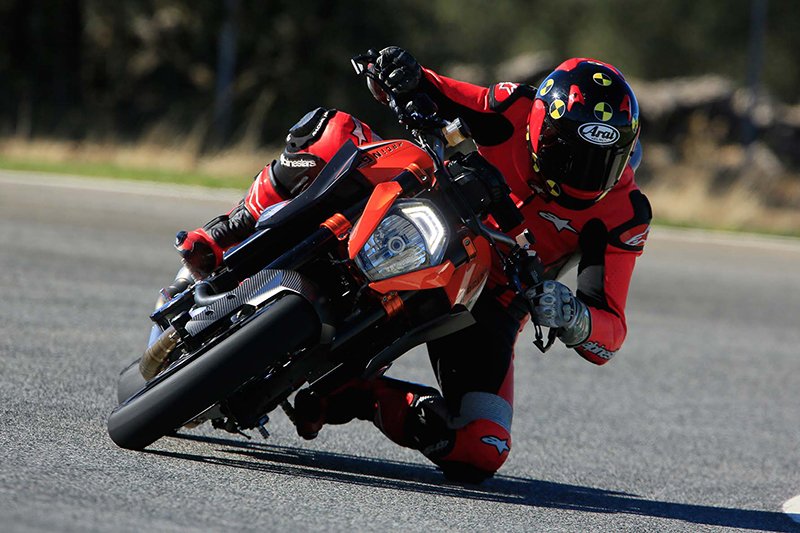
I do not suggest that all one-piece suit riders ride like this; far from it. But it is nevertheless true that a leather suit will often bring out the Rossi in us. I have had lots of superbikes and have done lots of road miles on them in my race suit, and I remember how, thus attired, it could turn any deserted A-road into a road racing circuit.
Now if we go back to that cognitive dissonance thing, you may not be surprised to hear that the guys who always ride in one-piece leathers are able to provide a whole host of rationales for their choice of dress. Number one is nearly always safety and protection. And there is some truth in this because, obviously, leather is very abrasion resistant.
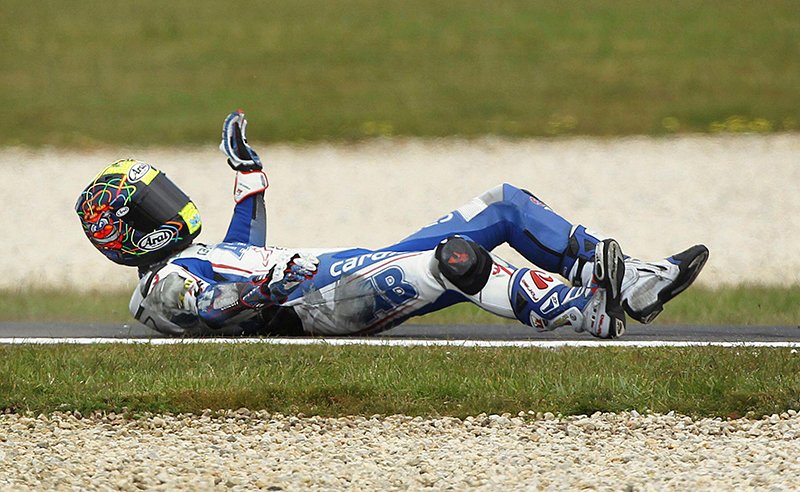
But, frankly, abrasion resistance is not the issue on the road that it is on the track. On the track you can slide twenty or thirty metres, or more. On the road, this is very, very rarely the case. Our roads are narrow, busy with other vehicles and often bordered by trees, fences and walls. And so when you come of your bike you don’t tend to slide too far. Instead you hit things: curbs, traffic islands other vehicles and so on. And when you hit things, the abrasion-resistant qualities of a leather suit count for very little. When you hit something what is potentially going to protect you is the armour; the armour in the knees, the hips, the shoulders, the elbows, the back and maybe the chest. Whether you are wearing a textile suit or a leather one when you hit something will make little difference to the outcome. And so what this means is that, on the road, the safety benefits that some riders believe a leather suit confers upon them are far less than they perceive them to be.

What I am going to talk about now applies not only to one-piece leathers, but to pretty much all leather garments
Most leather motorcycle garments tend to work across a fairly narrow range of climactic conditions. As long as it is not too hot or too cold, and provided it doesn’t rain, you can ride fairly comfortably in leather.
But if it gets really hot, any leather suit, one-piece or two, can rapidly bring you to boiling point, because leather is not particularly breathable. A leather suit might be fine for the 45 minute duration of a Moto GP in Jerez, but less so if you’re going to spend the whole day in the saddle. Yes, some leather suits have perforated panels and even vents, but the truth remains that leather is not the best material when it comes to allowing air to reach the body. Nor will it be very effective in terms of allowing sweat to escape into the atmosphere, which has to happen to allow the body to cool itself down.
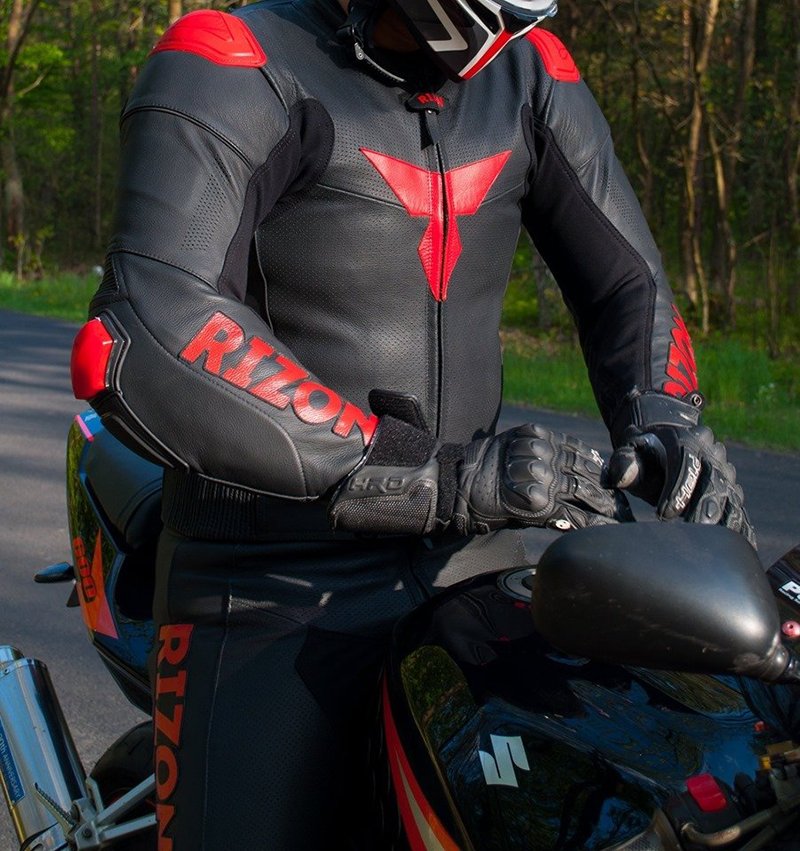
It’s no better if it gets cold, because leather itself has absolutely no thermal properties. You can wear layers for extra warmth, but as the sweat cannot escape through the leather, you will just get wet and sweaty. And as we all know, body heat is lost through a wet medium far faster than it is through a dry one.
But there’s worse still if the heavens open. Imagine a dry chamois leather dropped into a bucket of water. That’s effectively what happens to your leather suit when it rains. The result is not very comfortable. The leather will get heavy and it will start to chafe. Before long you will be shivering.
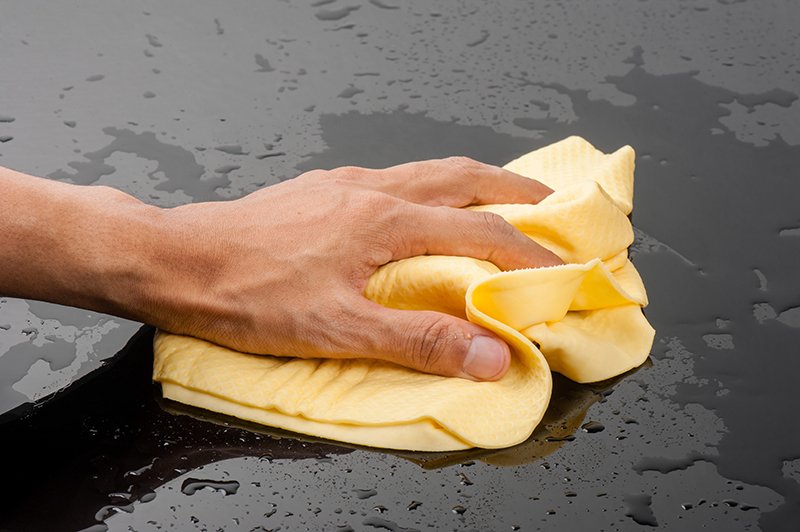
I know this all too well. I remember, many years ago, riding from Clermont Ferrand back to Calais without a minute’s let up in the rain. We stopped for lunch, and we had to to take our suits off to stop shivering, (the kind lady let us eat in a back room). Taking our suits off was not pleasant. Putting our still-soaking wet leathers back on afterwards, even less so!
And so whilst we would never attempt to deny that leather is incredibly strong and abrasion resistant, in any kind of extreme of weather, leather will quickly reach its level of incompetence. As bikers, what we want is to always be as comfortable in the saddle as we possibly can be. And this is why, in anything but the most benign conditions, one would tend to choose textile garments over leather ones.
If you want to remain comfortable on the bike across a wide array of weathers, then it’s a textile outfit that you’re going to need.
Depending on the nature of the weave, textiles can be made to be extremely breathable. A particularly loose weave will give you a mesh-style jacket; perfect for riding in hotter conditions. The oncoming air will reach the body more easily to cool the rider down. The loose weave will also make it easier to perspire. This is important because sweating is the body’s natural way of cooling itself down.
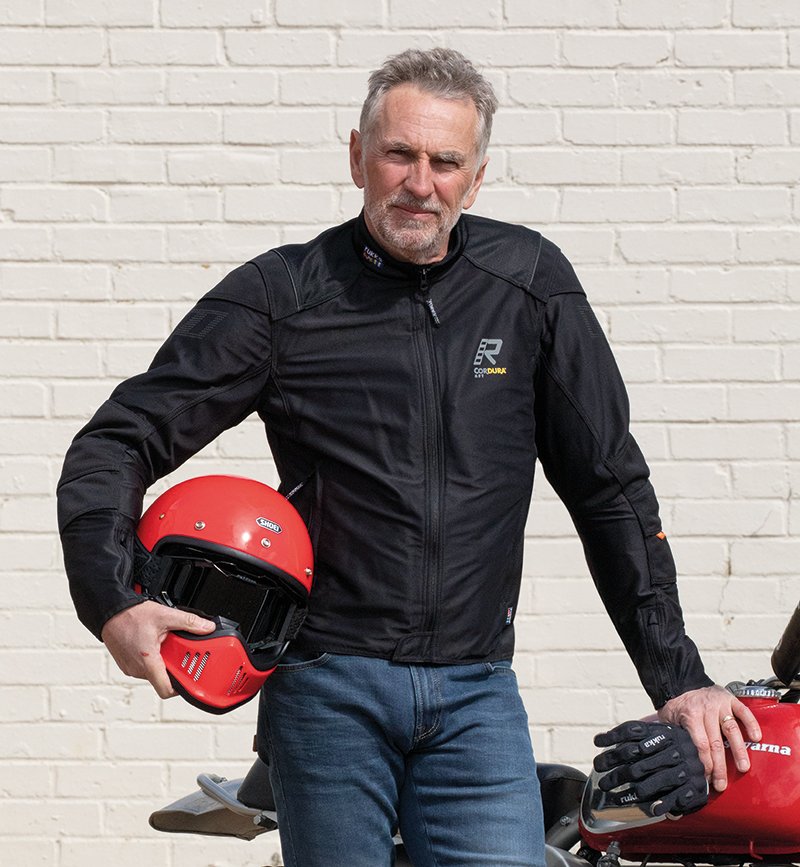
A tighter, denser weave of a stronger material can give a garment a tougher, more abrasion-resistant outer shell.
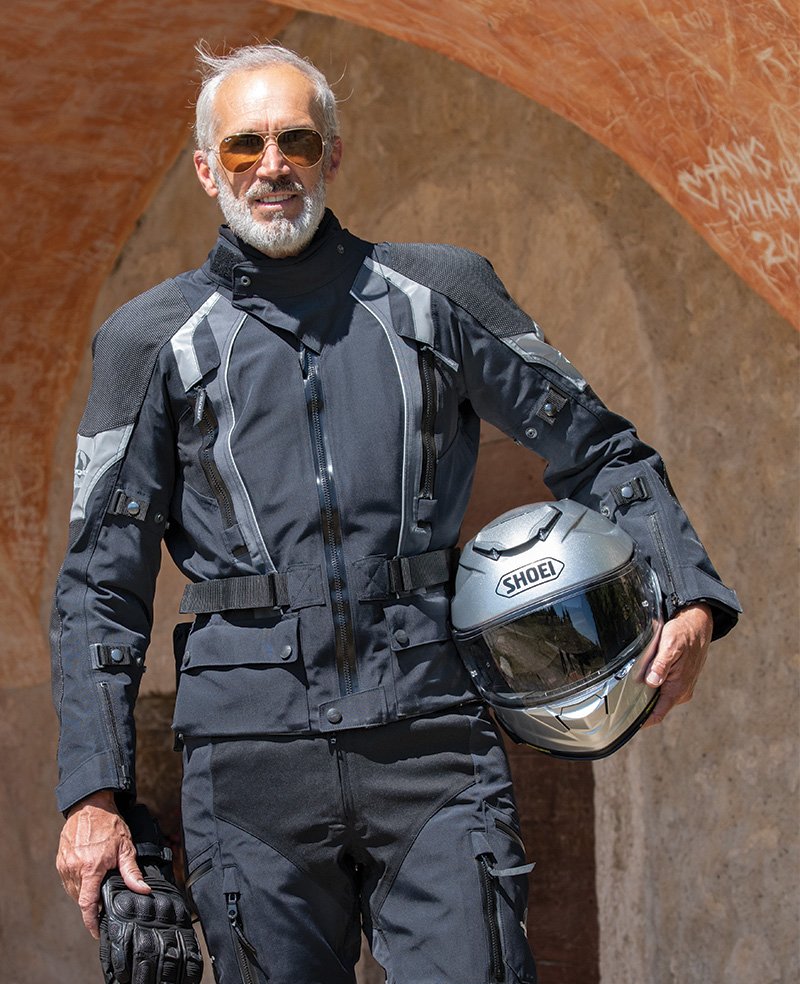
When you back a textile shell with a membrane, you will create a garment that is both more wind resistant and therefore warmer but also, of course, waterproof. Water doesn’t soak into textile fabrics in the way it does into leather. So the most waterproof garments will always be textile based, be they drop-liner or laminated in construction.
The secret of the membrane in any motorcycle garment is that the millions of tiny holes in the membrane prevent rain from reaching the body, but still allow the sweat as vapour to escape, thus allowing you to stay dry from both the outside and the inside.
The membranes in leather suits don’t tend to work particularly well; and again that’s because leather is not breathable. Your sweat can’t escape into the outer atmosphere, so you end up getting wet from the inside.
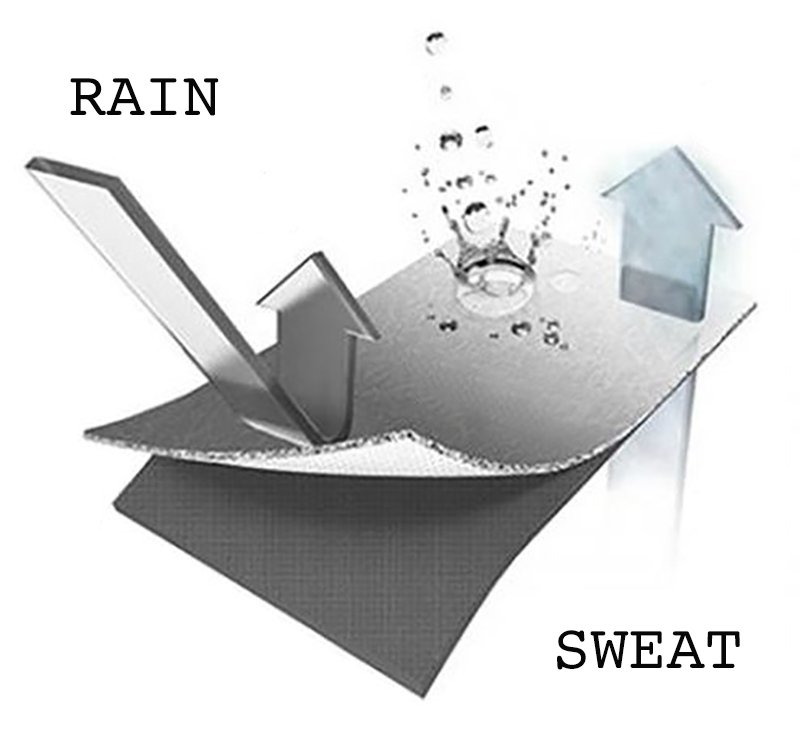
A textile garment will also be what you need if you want to stay warmer. Staying warm on the bike is basically about insulating heat from the body. And textile garments will be better than leather in this respect because, once more, the sweat that this generates will be able to escape. And as we’ve discussed before, only if your sweat can escape will you stay dry on the inside. And only if you stay dry on the inside can you prevent the loss of body heat.
So, on anything but a mild day, textile garments are better to ride in. And this is crucial from what we call a ‘passive’ safety perspective.
In motorcycling we talk about ‘passive’ safety and ‘active’ safety. Active safety is all about the physical components that we can surround ourselves with to protect us in the event of an accident. That is to say the strength of the materials we wear, the armour and things like airbags. These are the elements that, if it all goes Peter Tong, will protect our bodies from abrasion and better absorb the energy of an impact.
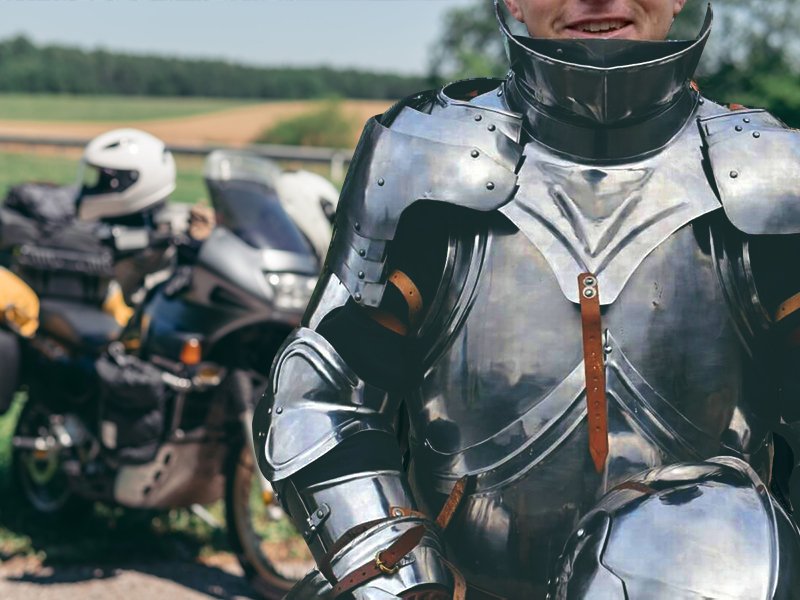
But the central dilemma is this. There is often a trade-off between ‘passive’ safety and ‘active’ safety. If we prioritise ‘active’ safety we wear only the thickest, heaviest leather clothing, the most energy absorbent armour, including of course a chest protector, the strongest boots, the most robust gloves, a neck brace and probably an airbag vest too. Like this we will perhaps bounce better when we come off the bike. But because we will lose mobility on the bike and risk getting too hot, too cold or too wet, we will almost certainly increase the chances of having an accident in the first place. (As an aside, in so doing we also risk removing all the fun from riding a bike).
I was talking to one of our customers about this recently. He’s a Marine, and he told me that it was central to their tactical approach that they try never to allow protection to hamper mobility. I suppose this is analogous to the point I am trying to make here.
Staying alive on a motorcycle entails being able to devote all your faculties to the job in hand. Only if you are totally relaxed on the bike can you concentrate on the road conditions, the effects of the weather, the traffic and, in particular, that guy up ahead on the left in a Transit van who is indicating right but still talking on the phone.

And so we have a situation where, important as it is to wear protective clothing in case an accident happens, wearing clothing that will cause you to be more relaxed on a bike might well put you in a situation where you are much less likely to have an accident in the first place.
We all want to ride safe. Riding a motorbike is hugely exciting and entertaining. But equally it can be dangerous in the extreme. The clothing we wear can make a huge difference to how we ride.
Humans have been wearing leather for protection since the Ice Age. The cow hide we use in motorcycle clothing today is no different to the hide of cows five hundred of even a thousand years ago. The arse of a cow back then is pretty similar to the arse of a cow now. Leather is not a sophisticated product. It is comfortable, it moulds to the body and it is very strong. It can also look super cool.
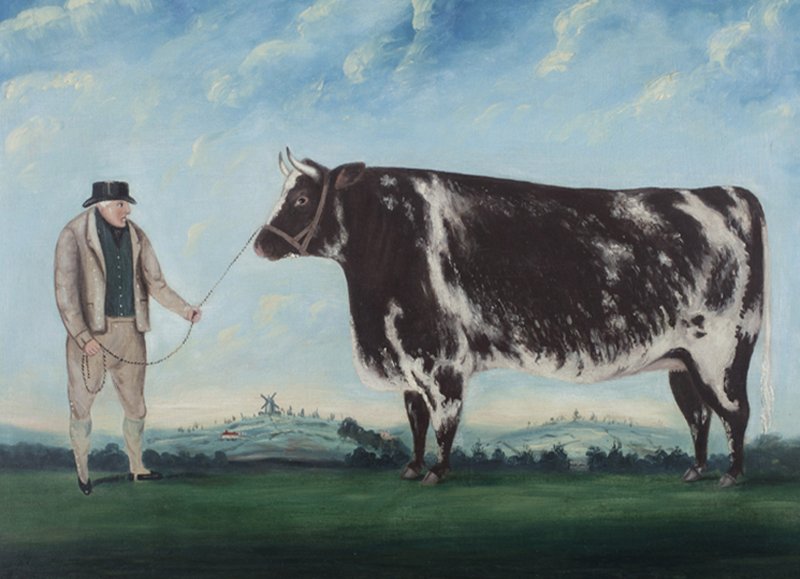
There are times when riding in leather gear is the way to go. If the conditions are right, there’s nothing nicer to wear than leather.
But if the mercury in the thermometer rises or falls by more than a few degrees, or if it rains, it won’t take long to realise that you might have been wrong to go out in your leather outfit.
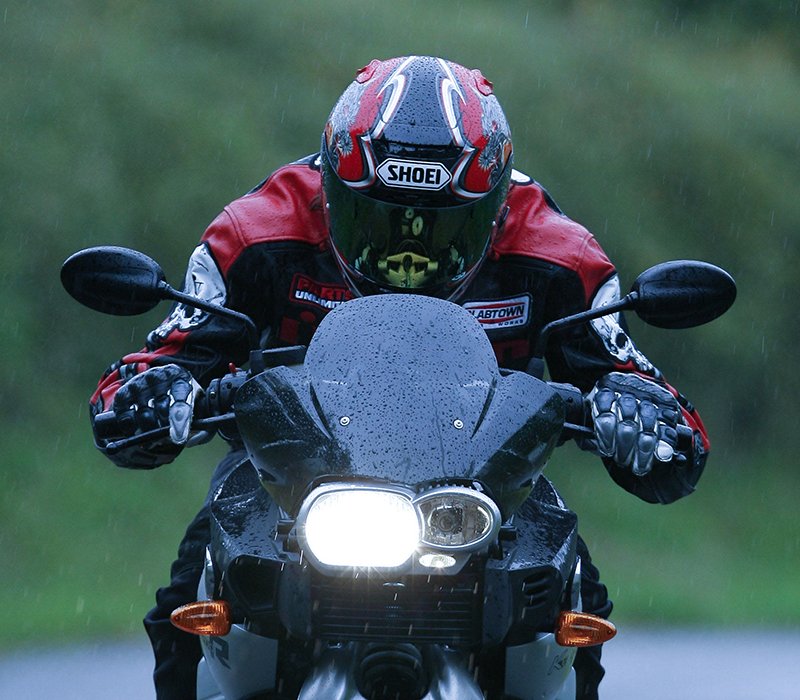
Of course, the traditionalists will claim that there’s nothing that can’t be overcome with a set of waterproofs and and some appropriate base layers. And although they wouldn’t be totally wrong, they wouldn’t be completely right either.
So where do we get to? Well, as in most things in life, there are no rights and no wrongs; there are just shades of opinion. You will have to be guided by your own deliberations.
Because I don’t tend to pay for my gear, it’s easy for someone in my position to say, but for me there are times where it has to be a one-piece (always on the track), there are times when I like to ride in a leather two-piece; where the temperature is just so-so and I know I might occasionally be reaching the national speed limit! And there are times when, rather sadly, I try and convince myself that I can look cool; and that’s when it’s got be a cafe-racer jacket of some description. And then there’s the rest of the time- and given that this is Britain, that means most of the time- where I will wear textile gear, because I want to keep cool, stay dry or stay warm. So that I can ride in a totally relaxed fashion, and stay safe
So, as always in reviews like this, there’s no winner I’m afraid. Sorry!
Share this story
































































